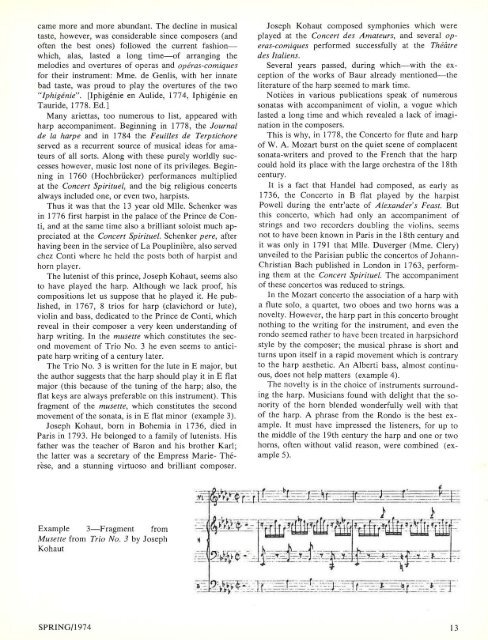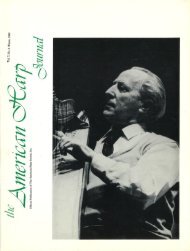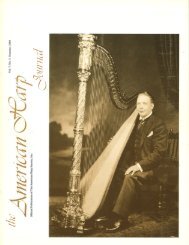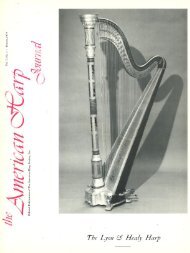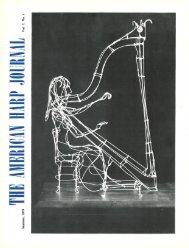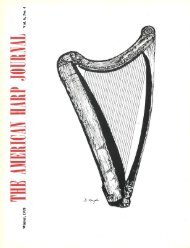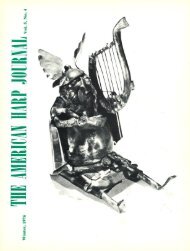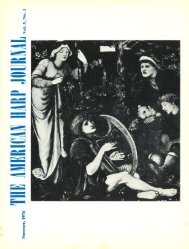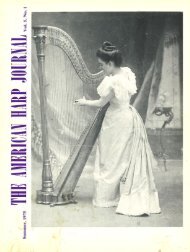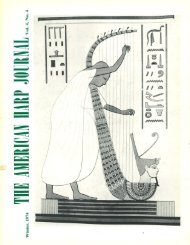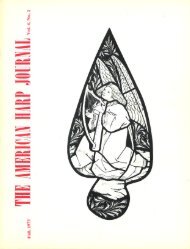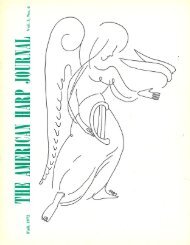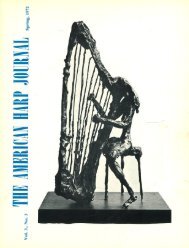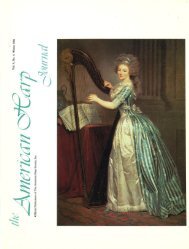Create successful ePaper yourself
Turn your PDF publications into a flip-book with our unique Google optimized e-Paper software.
came more and more abundant. The decline in musical<br />
taste, however, was considerable since composers (and<br />
often the best ones) followed the current fashionwhich,<br />
alas, lasted a long time--of arranging the<br />
melodies and overtures of operas and operas-comiques<br />
for their instrument: Mme. de Genlis, with her innate<br />
bad taste, was proud to play the overtures of the two<br />
"Iphigenie". [lphigenie en Aulide, 1774, Iphigenie en<br />
Tauride, 1778. Ed.]<br />
Many ariettas, too numerous to list, appeared with<br />
harp accompaniment. Beginning in 1778, the Journal<br />
de la harpe and in 1784 the Feuilles de Terpsichore<br />
served as a recurrent source of musical ideas for amateurs<br />
of all sorts. Along with these purely worldly successes<br />
however, music lost none of its privileges. Beginning<br />
in 1760 (Hochbriicker) performances multiplied<br />
at the Concert Spirituel, and the big religious concerts<br />
always included one, or even two, harpists.<br />
Thus it was that the 13 year old Mlle. Schenker was<br />
in 1776 first harpist in the palace of the Prince de Conti,<br />
and at the same time also a brilliant soloist much appreciated<br />
at the Concert Spirituel. Schenker pere, after<br />
having been in the service of La Poupliniere, also served<br />
chez Conti where he held the posts both of harpist and<br />
horn player.<br />
The lutenist of this prince, Joseph Kohaut, seems also<br />
to have played the harp. Although we lack proof, his<br />
compositions let us suppose that he played it. He published,<br />
in I 7 6 7, 8 trios for harp ( clavichord or lute),<br />
violin and bass, dedicated to the Prince de Conti, which<br />
reveal in their composer a very keen understanding of<br />
harp writing. In the musette which constitutes the second<br />
movement of Trio <strong>No</strong>. 3 he even seems to anticipate<br />
harp writing of a century later.<br />
The Trio <strong>No</strong>. 3 is written for the lute in E major, but<br />
the author suggests that the harp should play it in E flat<br />
major (this because of the tuning of the harp; also, the<br />
flat keys are always preferable on this instrument). This<br />
fragment of the musette, which constitutes the second<br />
movement of the sonata, is in E flat minor (example 3).<br />
Joseph Kohaut, born in Bohemia in 1736, died in<br />
Paris in 1793. He belonged to a family of lutenists. His<br />
father was the teacher of Baron and his brother Karl;<br />
the latter was a secretary of the Empress Marie- Therese,<br />
and a stunning virtuoso and brilliant composer.<br />
Joseph Kohaut composed symphonies which were<br />
played at the Concert des Amateurs, and several operas-comiques<br />
performed successfully at the Theatre<br />
des Italiens.<br />
Several years passed, during which-with the exception<br />
of the works of Baur already mentioned-the<br />
literature of the harp seemed to mark time.<br />
<strong>No</strong>tices in various publications speak of numerous<br />
sonatas with accompaniment of violin, a vogue which<br />
lasted a long time and which revealed a lack of imagination<br />
in the composers.<br />
This is why, in 1778, the Concerto for flute and harp<br />
of W. A. Mozart burst on the quiet scene of complacent<br />
sonata-writers and proved to the French that the harp<br />
could hold its place with the large orchestra of the 18th<br />
century.<br />
It is a fact that Handel had composed, as early as<br />
1736, the Concerto in B flat played by the harpist<br />
Powell during the entr'acte of Alexander's Feast. But<br />
this concerto, which had only an accompaniment of<br />
strings and two recorders doubling the violins, seems<br />
not to have been known in Paris in the 18th century and<br />
it was only in 1791 that Mlle. Duverger (Mme. Clery)<br />
unveiled to the Parisian public the concertos of Johann<br />
Christian Bach published in London in 1763, performing<br />
them at the Concert Spirituel. The accompaniment<br />
of these concertos was reduced to strings.<br />
In the Mozart concerto the association of a harp with<br />
a flute solo, a quartet, two oboes and two horns was a<br />
novelty. However, the harp part in this concerto brought<br />
nothing to the writing for the instrument, and even the<br />
rondo seemed rather to have been treated in harpsichord<br />
style by the composer; the musical phrase is short and<br />
turns upon itself in a rapid movement which is contrary<br />
to the harp aesthetic. An Alberti bass, almost continuous,<br />
does not help matters (example 4).<br />
The novelty is in the choice of instruments surrounding<br />
the harp. Musicians found with delight that the sonority<br />
of the horn blended wonderfully well with that<br />
of the harp. A phrase from the Rondo is the best example.<br />
It must have impressed the listeners, for up to<br />
the middle of the 19th century the harp and one or two<br />
horns, often without valid reason, were combined (example<br />
5).<br />
Example 3-Fragment from<br />
Musette from Trio <strong>No</strong>. 3 by Joseph<br />
Kohaut<br />
SPRING/<strong>1974</strong> 13


